If you’re looking for a cheap or free open source ecommerce platform, you’ve come to the right place.
Well, technically, you could choose just about any ecommerce framework, since the majority of them are rather inexpensive as it is.
However, the open source model has brought about all sorts of praise from the people who use it, especially considering these online store systems are completely free, they’re managed and developed by numerous people around the world, and you can typically find lots of documentation and blog posts to guide you along your way.
When researching and choosing any of these ecommerce frameworks, it’s important to decide the type of development experience you’re looking for.
Here are a few questions you should consider asking yourself:
Are you interested in self-hosting? Like hosting with InterWeb SA for example.
Or would you rather pay a small fee per month to have hosting and all ecommerce features wrapped up in one nice package?
One of the main decisions is whether you’d like one of the open source (free) ecommerce platforms or a more user-friendly one that involves a monthly fee.
For instance, you could opt to pay as little as R200 per month for an ecommerce platform like Shopify, which has everything like hosting, a website builder, plugins, marketing tools, and inventory options included.
I personally would never go with an option like Shopify over an open source system,here are some reasons why:
- Open source ecommerce frameworks are free.
- You often have more creative control over the design and how the store works.
- Open source solutions are often packed with more unique features because they are constantly being developed.
- You can control things like hosting, plugins and themes that would go into your store.
- Open source systems are built by a community. They are incredibly developer friendly and there is great support available from fellow developers.
As always, there are several downsides to open source:
- Open source ecommerce platforms typically require more development or coding knowledge (but you can always hire a developer).
- You have to look around to find a server for hosting by yourself.
- All the site related operations such as maintenance, security, and speed optimization have to be done by you.
- The website designers are usually less user-friendly compared to ones in major ecommerce frameworks like Shopify.
- You don’t get dedicated support. So, if you’re someone who needs to call or email a support rep, open source might not be for you.
20 Best Free Ecommerce Platforms in 2020
It’s entirely up to you to decide which type of platform is right for you, but for now, let’s talk about the best free and open source ecommerce platforms on the market.
1. Square Online Store – Best Overall Free Ecommerce Platform
If you’re not particularly eager to join the Wix premium plan bandwagon, you might want to try out Square Online Store.
Now, for a long time, Square had fundamentally existed as a versatile payment solution. Until it finally decided to spread its wings by setting up a multi-faceted business ecosystem.
So far, quite a number of people are aware that Square increasingly facilitates merchants dealing with physical businesses restaurants, coffee shops, and so forth. While that’s fairly accurate, it turns out that Square has now grown to be much more than that.
In essence, the platform offers a myriad of extensive features plus integrations that not only support brick and mortar businesses, but also ecommerce websites.
And no, we’re not only talking about digital payments here. But rather, the entire ecommerce framework. Square offers tools for pretty much all the critical online store functions- from inventory management and sales, to marketing and team coordination.
All things considered, the most outstanding feature here is the ability to set up a fully-functional ecommerce website for free.
You don’t need to pay anything to build an online store. Not even for hosting. In fact, you can proceed without the slightest bit of knowledge about coding.
Creating free ecommerce websites with Square is as easy as 1-2-3. After you select an ideal theme from the array of predesigned customizable options, just make some tweaks, and voila!
Ultimately, you’ll achieve the full online store experience. And in case the default features happen to be inadequate, you can leverage Square’s integrations to link your free ecommerce website with third-party apps for booking and scheduling, employee and inventory management, accounting, plus much more.
But that’s not all. If you have some coding tricks up your sleeve, you can consider capitalizing on the Square Connect API to build your own specialized integrations. Otherwise, it’s also possible to link free ecommerce sites with their corresponding offline brick and mortar counterparts. This feature alone is particularly handy for streamlined multi-store selling and product management.
That said, I can guess what you might be wondering at this point. How the heck does Square generate revenue from this?
Well, interestingly, there are no ecommerce web monthly plans on this platform. Not even one. Instead, it basically charges a fixed rate of 2.9% plus 30¢ for each online transaction. Therefore, ecommerce sites are genuinely free on a permanent basis.
Benefits of Square
- Setting up a complete ecommerce website is fairly easy. Simply download the online store app, install it into your computer, and then launch its user-friendly drag-and-drop editor to design a unique site for free.
- While building ecommerce sites is actually free of charge, the subsequent pricing framework is quite straightforward and favorable. You essentially get to pay 2.9% plus 30¢ when you start selling, which is admittedly reasonable compared to the standard transaction fees on other platforms.
- Square shares an exceedingly diverse ecosystem with third-party app integrations. You can take advantage of this to set up additional ecommerce website functionalities. Or otherwise, use the Square Connect API for your own unique integrations.
- If you have a decent social media following, you can consider extending your ecommerce site to sell items on Pinterest, Facebook, and Twitter. Consequently, the entire inventory will be synced in real-time across all the sales channels for streamlined management.
- Square is a comprehensive selling platform that facilitates both online and offline selling.
Downsides of Square
- Although excluding comprehensive underwriting from the start makes it incredibly easy to build ecommerce sites, it turns out there’s a caveat. Square Online Store is apparently infamous for frequently holding funds over transactions it considers suspicious. The platform continues to do so in a bid to protect itself from possible online fraud.
- Square is only ideal when it comes to basic ecommerce websites. Due to the simple nature of its functionalities, you might find it difficult to create or run a complex online store. You can only do that on a dedicated ecommerce platform like WooCommerce.
- Square does not have an entirely reliable customer support system. Although it offers support through phone, social media and email, it mostly prefers using the latter two. Plus, the platform is yet to set up live chat support.
2. WooCommerce (On WordPress) – Best Open Source Ecommerce Platform
WooCommerce (read how to use woocommerce here) is a WordPress plugin, so you’ll have to install WordPress (open source) on your host, then install the WooCommerce plugin onto your site.
You simply just:
- Log into your WordPress site.
- Go to: Plugins > Add New.
- Searchfor ‘WooCommerce’.
- Select Install Now.
- Select Activate Now and you’re ready for the WooCommerce Wizard!
It automatically turns any WordPress website into a fully functional online store, with inventory management, coupons, and product pages.
Benefits of WooCommerce:
- The plugin is free to download and install. Many stores don’t need anything more than the plugin.
- It connects to all major payment gateways. By default, you are given PayPal and Stripe which are two of the most recognised gateways on the market. Additionally, you can accept payments via Amazon Pay and PayFast
- With a WooCommerce theme, you hardly have to do any work besides adding content. You can get a theme from the official WooCommerce store, additionally, you can use a third party website such as Themeforest which has the largest reposistory of WooCommerce themes on the market.
- You can offer coupons and discounts, along with adding multiple other features with the help of the extension library.
- WooCommerce is a very popular platform which means there is fantastic support available. It’s worth noting that you should always ensure that you are on the latest version of the plugin before requesting any help

Within WooCommerce’s help centre there are 5 options which can provide you with the answer you are looking for.
- WooCommerce 101 – you can watch video material which gives you an explanation in regards to the page you are looking at.
- Help & Support – here you can find links to documentation, the WordPress.org forum as well as the WooCommerce Help Desk where you can submit a ticket.
- Found a bug? – if you spot a bug you can submit these to the WordPress team. You will have to explain in detail what you found and provide screenshots
- Education – WooCommerce has a host of partners which provide customers with courses and training
- Setup Wizard – this wizard puts you back to the beginning and takes you through the process of setting up WooCommerce pages, shipping, taxes and payments.
Downsides of WooCommerce:
- There are plenty of extra expenses such as a WooCommerce theme, extra extensions, hosting, and domain name. It may label itself as free, however, a theme may set you back more than $100 dollars, the domain will be $30 and hosting can be anything from $4 a month to $5,000 for enterprise websites
- WooCommerce has several moving parts. On the surface, it requires hosting + WordPress + the WooCommerce plugin. Beginners can get intimidated by this, especially with tasks like SEO, security, hosting, and caching. There is a big learning curve if you are just starting out which is why new starters opt for something such as Shopify
- You will need some technical knowledge and developer skills for WooCommerce to be cost-effective. If not you will have to outsource to WooCommerce’s selection of ‘WooExperts’ who offer hourly prices and project prices which can be costly
3. CS-Cart Multi-Vendor
CS-Cart is a renowned Russian software company that has served ecommerce merchants since 2005.
Now, I’ve purposely left out the “Multi-Vendor” part because the company happens to distribute two different CS-Cart ecommerce applications.
For starters, there’s the “CS-Cart” platform, which is basically a shopping cart software with the essential features for getting a typical online store up and running.
Then secondly, we have the CS-Cart Multi-Vendor platform, which is also an ecommerce software, but a little bit different compared to its CS-Cart sibling.
You see, CS-Cart Multi-Vendor is not for online merchants seeking to set up ecommerce stores. Rather, it targets the big players (mostly enterprises) that would like to build marketplaces. I’m talking about creating websites like eBay or Etsy, which usually host numerous merchants under one roof.
So, in short, CS-Cart Multi-Vendor can help you build your own marketplace, complete with the corresponding features that small merchants might need to create their storefronts on your website.
The solution itself is self-hosted and comes with an open-source framework, which features over 500 ecommerce functionalities, as well as themes, and extra integrations.
The problem is, however, that CS-Cart Multi-Vendor is not entirely free. In fact, there’s nothing much you’ll be getting for free. The far CS-Cart Multi-Vendor goes is offering you a 15-day free trial, followed by a 30-day risk-free purchase period. That means they’ll refund all your money if you don’t like their software product.
Now, on the bright side, you won’t be paying for the service on a monthly basis. CS-Cart Mult-Vendor is provided at a one-off cost of either $1,450, $3,500, or $7,500. What you pay, in the end, depends on the features you’re looking for.
But, if you ask me, it’s totally worth the price since it offers everything you can think of. It even comes with its own layout editor, along with great SEO and marketing tools, an in-built content management system, a user-friendly admin panel, a responsive mobile-friendly structure, plus integrations for more than 80 payment and shipping services.
Then considering it’s an open-source application, you can, of course, build your own custom functionalities and integrations. The possibilities here are limitless.
Ultimately, you, as the purchaser, become the head of the marketplace. CS-Cart Multi-Vendor allows you to host vendors, all of whom you’ll coordinate from the primary admin panel.
In other words, the admin panel gives you the power to control everything about the marketplace – from its vendors and their accompanying payouts, to the overall marketplace architecture and design. It’s just like building an online mall from the ground up, and subsequently managing its merchants.
Well, the vendors, on the other hand, are required to register like they would on any other marketplace platform. Then once you approve their details, they can proceed to set up their own marketplace storefronts.
The storefronts themselves can sell different types of products and services. Both physical and digital products are allowed here. So, in the end, it all depends on what you choose to have your vendors dealing in.
That said, CS-Cart Multi-Vendors will give your vendors their own admin panels for managing their stores, as well as configuring features such as product categories, filters, search, shipping options, etc. Then in the meantime, you can have them pay via a monthly subscription schedule, sales commissions, or possibly both. The choice is yours, so be wise about it.
Otherwise, you can find out all the juicy details about CS-Cart Multi-Vendor from our comprehensive review here.
Benefits of CS-Cart Multi-Vendor
- CS-Cart Multi-Vendor is as comprehensive as marketplace ecommerce platforms come. It offers you all the features you might need to set up and manage a virtual online mall. Plus, your vendors get the essential storefront functionalities and integrations. They even have the privilege of choosing customizable themes for their online stores.
- CS-Cart Multi-Vendor is a self-hosted ecommerce platform that you acquire and install into your server of choice. Then from that, you get to run and manage all the resultant tools. This translates to unlimited flexibility, especially considering it’s also an open-source system.
- Although CS-Cart Multi-Vendor is not a completely free open-source ecommerce platform, it’s sold for a one-off price. So, there are no monthly subscription headaches.
- The CS-Cart Multi-Vendor application is accompanied by comprehensive documentation and video tutorials. You should be able to troubleshoot any issues that develop along the way, as well as understand how the whole system works.
- CS-Cart Multi-Vendor has seemingly prioritized online marketing. It features a wide range of SEO and digital promotion tools that vendors can capitalize on to grow their businesses.
- Another thing that the platform prioritizes is security. It continues to release multiple updates every year, which come as feature upgrades or patches for resolving vulnerabilities. So, you’re guaranteed up-to-date security capabilities.
- The primary admin panel is elegantly designed to give you seamless user experience. The navigation is straightforward and the menu options are neatly organized for convenient access. Therefore, it doesn’t take much to learn the ropes here.
Downsides of CS-Cart Multi-Vendor
- CS-Cart Multi-Vendor is not an entirely free open-source ecommerce platform. After a 15-day free trial period, you’re required to purchase the software for at least $1,450. The other two packages cost $3,500 and $7,500.
- Since it’s self-hosted, you need to invest in a third-party hosting solution, as well as a developer for setup and subsequent maintenance.
- While we appreciate the gesture, the money-back guarantee period only lasts for 30 days. Such a period might not be enough for a deep analysis of the CS-Cart Multi-Vendor features and capabilities.
- Although the principal admin panel is intuitive and easy-to-use, it’s a different story altogether when we shift to the vendors’ side. Their interface might not be as simple, as say eBay’s or Amazon’s. Hence, they may need some time to get used to the tools and functions.
4. nopCommerce
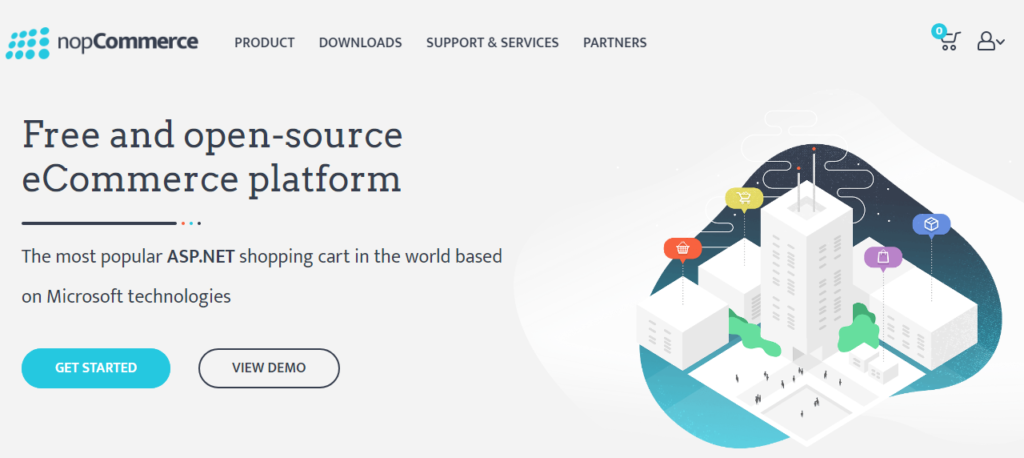
nopCommerce is yet another ecommerce platform with a Russian origin. But, unlike CS-Cart Multi-Vendor, it’s a completely free open-source ecommerce platform built for online stores.
Since 2008, nopCommerce has so far attracted over 2.5 million downloads and for good reasons. If you want to join the bandwagon, you can go ahead and acquire the Microsft ASP.NET-based platform directly from its company website. There’s even a one-click install version available for download, and it comes without the source code.
But, if you’re a developer, it goes without saying that the alternative source code version is the best. You can rework it whichever way you want. Otherwise, you could also download the source code from GitHub.
Now, the subsequent setup process shouldn’t take you long, particularly if you choose to proceed with the one-click installer. Large enterprises, however, would probably take longer as they need time for tweaking nopCommerce’s underlying hood.
Whichever route you pick, you’ll ultimately discover the good reasons that have won nopCommerce many users.
Once you have it up and running, you’ll notice that it’s structured to support both beginner merchants and demanding ecommerce experts. In other words, nopCommerce is capable of serving all types of establishments- from startups and small businesses to medium-sized businesses and large enterprises.
Its comprehensive toolset includes a flexible shopping cart (complete with all the corresponding ecommerce features), an administration panel for managing and tracking your online business, as well as a storefront-end for hosting customers.
The default nopCommerce platform also comes with a host of SEO-friendly features to make your online marketing easy. Its product pages, for instance, are well-optimized for SEO URLs and search engine-friendly content.
Moving forward, it turns out nopCommerce doesn’t restrict you to just one online store. It’s flexible enough to support multiple stores across different domains, all of which are managed from one central admin panel. That essentially means it’s perfect for large enterprises handling an extensive portfolio of ecommerce stores.
Interestingly, nopCommerce doesn’t stop there. It goes ahead and offers marketplace integrations that basically transform your store into a virtual online mall- very much like CS-Cart Multi-Vendor. Consequently, all your vendors’ products are displayed collectively, with the subsequent sales proceeds being directed to the respective merchant accounts.
Benefits of nopCommerce
- nopCommerce is an open-source ecommerce platform that’s available free of charge. You won’t pay anything to acquire and use it for the long haul.
- There are two main nopCommerce download options. Online merchants who are not familiar with programming can download the simplified one-click install version that doesn’t come with the source code. Developers, on the other hand, could choose to proceed with the source code version for its extensive customization capabilities.
- nopCommerce comes with all the essential features you’d need for setting up a fully-functional online store. Hence, you should be able to sell different types of products and services, configure SEO settings, manage all the ecommerce parameters, integrate additional third-party apps, as well as rework the underlying code.
- nopCommerce is capable of facilitating numerous ecommerce stores on a single admin interface. You could also build a marketplace where small vendors could collectively sell their stuff.
- nopCommerce is supported by a large, vibrant community of developers who are spread out across the world. They are consistently improving the platform to make it better, faster, and more secure.
- nopCommerce now boasts of thousands of prebuilt integrations. All that comes from various developers who’ve created integrations with popular shipping, payment, marketing, site building, and hosting solutions. So, of course, you should be able to connect your nopCommerce system to pretty much any popular ecommerce solution right off the bat.
- nopCommerce is not the type of ecommerce platform that suits all merchants. If you don’t have the skills for CSS, HTML, MS SQL, and .NET programming, you might have better luck with a simpler solution. nopCommerce fundamentally targets people who know how to work with Microsoft-based platforms.
- While downloading the nopCommerce software is completely free of charge, you might subsequently incur heavy charges for development services, thrid-party add-ons, themes, web hosting, plus an SSL certificate.
- Customer support is very limited here. Once you download and install nopCommerce, maintaining the whole platform plus troubleshooting any issues is entirely up to you.
5. X-Cart
X-Cart has helped to create over 35,000 online stores, and this has been growing rapidly over the past few years. As with all of these ecommerce platforms on the list, it’s free, open source and self-hosted.
X-Cart is often considered one of the fastest open source platforms on the market, and it also has an incredible number of features for you to sink your teeth into. There’s also a free trial for the premium plan, which goes for $495 (one-time payment).
Benefits of X-Cart:
- It depends on the package you go with, but you can often get full multilingual and multi-currency support. This is especially good if you are running an enterprise store
- You can integrate your shopping cart with the most reputable payment gateways in the world such as PayPal and Sage
- It’s free and open sourced so similarly to WooCommerce there is some great developer support available. It’s PHP code means you can easily add additional integrations manually
- The most advanced developers will have all the control they need with X-Cart. It’s pretty fun to play around with and is very scalable. As your store grows X-Cart can grow alongside you.
- You can also rest easy knowing that X-Cart is completely secure and PCI Compliant.
Downsides of X-Cart:
- You have no access to direct customer support unless you pay an extra fee. Other than that you will just have to rely on X-Carts self-help tools
- You even have to pay for hosting if you opt for one of the paid plans. Again this can cost anything from $5 a month to several thousand.
- Although the premium plan is only $495 for a lifetime, this still looks somewhat high compared to other options. Also if you need a multivendor plan and then continue to grow the price rises considerably
- There’s a good chance you’ll have to utilize some sort of manual coding when setting up your store. If you don’t need PHP code then you will have to outsource development work which will be costly
6. Zen Cart

The whole reason Zen Cart was created was so that people without development degrees could build their own online stores.
I wouldn’t go so far as to say that you don’t need any coding knowledge, but it’s pretty close.
But, I can assure you this, Zen Cart is more user-friendly than many of the other open source ecommerce platforms, so it might be worth looking into if you want to scale up quickly but you don’t have advanced developer skills.
Benefits of Zen Cart:
- Zen Cart is known as a rather secure software, so you know that your site and customer information is protected. Zen Cart knows that security is important and have provided some great security documentation.
- Zen Cart is also great for scaling up a store because of its wide range of features and full customization options. There are modules which developers have already created on Zen Cart which you can download and add to your store

- You can send out HTML emails directly from your website to leads and customers that you have already gathered.
- The Zen Cart community has been going strong for over a decade now which means there is a fantastic experience on hand to help you
- Zen Cart has some great multilingual options available if you are an enterprise store and you are looking to sell internationally

Downsides of Zen Cart:
- The platform doesn’t provide any dedicated support. The only way you will receive support is by hiring a dedicated third party.
- It can sometimes be difficult to upgrade your software, also customers have complained in the past that they have lost some of the custom options of their store as a result.
- Although there is a SEO out of the box tool, you need to purchase the more advanced features that other companies would offer for free such as sitemaps and meta tags

- There aren’t many add-ons or extensions and there have been reported issues of how they talk to each other. It’s likely you will run multiple plugins and some times they don’t play ball.
- The templates are far from impressive, but you can still find some made by third parties.
7. Magento Open Source – Most Popular Open Source Ecommerce Platform
Magento is one of the most popular open source ecommerce platforms, and for good reason.
To start, it has more features than you can ever expect to use. However, this opens up all sorts of avenues when it comes to marketing to your customers and creating things like membership plans, recurring payments, and discounts.
Do you seek complete control over the design and functionality of the site?
If the answer is a solid yes, consider Magento Open Source. It’s very similar to that of WordPress, where the community is strong, you can choose from hundreds of thousands of themes, and there are plenty of extensions to get your hands on.
Benefits of Magento:
- It’s free, and there’s a paid version if you want to upgrade and scale your business accordingly.
- You almost never need to look for an extension with Magento, since the feature list is overwhelming and is available right out of the box. This includes features such as coupons, sitemaps and bulk import/export as well as conversion tools such as one-page checkout and order tracking
- You can send out product alerts to customers for automated marketing. This can include price alerts and back in stock messages
- The platform lets you make separate multi-lingual sites that load up depending on the user’s location. This is a great feature for large or enterprise stores
- You can customize the user interface and admin area as well as your store so it will look unique
Downsides of Magento:
- Magento is packed with features, but that can also make it clunky and resource-hungry. Therefore, you might have to allocate a decent amount of money and time for optimization as this may slow down your site.
- Although you can learn how to use Magento, the main reason you would consider it is if you had development skills. Larger companies are known to go with Magento because they have the access and money to get a developer who knows development code.

- Similar to the other options so far you are on your own in regards to customer support
- Magento is very good for Enterprise customers which you can see above, so it can be quite expensive when you take into consideration the costs for themes, hosting and the domain.
8. OpenCart
Compared to other open source platforms, OpenCart is actually pretty easy to use and lightweight. It’s free and there is a decent community to turn to if you have problems when designing your store.
I recommend it for startups since it doesn’t take too much time to customize the website from scratch.
Due to the ease of use, the overall cost of setting up a store typically decreases. For instance, you don’t have to pay for a special developer, and the themes aren’t expensive.
The lookout and user experience has dramatically improved over the past few years and is much more user-friendly.
Benefits of OpenCart:
- The startup costs are pretty low, the download is free and there are some great themes which are available for free as well
- The features are solid, and the large catalog functionality works wonders for order processing. For example, Open Cart offers different sizes, colors, length and height as product options out of the box.
- The average person should be fine with setting up OpenCart. Not to mention, it doesn’t suck down resources like Magento and they learning curve is much less time-consuming than Magento.
- Open Cart offers access to the most renowned payment gateways as well as the more niche ones that you may have a preference towards
- Do you have multiple stores or plan to? You can set products to appear in different stores as well as offering different prices on each. You can then personalise each store as you wish
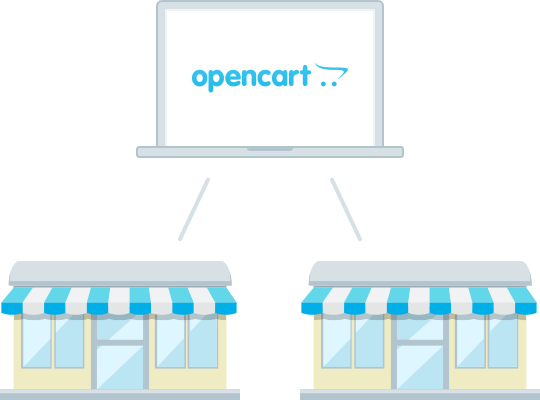
Downsides of OpenCart:
- When you look at the feature list of Magento compared to OpenCart, it’s no comparison. Magento is probably OpenCart’s biggest competitor in this list but Magento wins by a landslide in regards to features.
- You will need to add lots of add-ons for OpenCart to work for you which means it can get very expensive.
- Although it’s easier to use for beginnners, this means that the customization options are also fewer. You might consider OpenCart as one of the few open source ecommerce platforms that experienced developers would rather avoid.
- Similar to Zen Cart the updates that are rolled out can cause issues to your website if it has a lot of custom elements on it. Bugs will invariably appear as they can’t be tested on every custom website
9. PrestaShop – Best Open Source Ecommerce Platform for Startups
PrestaShop is somewhat new in the ecommerce platform game, but it’s made a name for itself with its ease of use and the beautiful interface it provides. Another thing to consider is that it doesn’t take much experience to install the plugin and get started on building your store.
Therefore, small start-up businesses will find it pretty easy to get started.
Benefits of PrestaShop:
- PrestaShop has a user-friendly interface with effortless inventory management and a process for store maintenance that anyone could understand. Additionally, you can use PrestaShop’s live demo before you register so you can have a little try
- PrestaShop provides a beautiful interface for establishing different websites for multiple languages and currencies. You can also translate the back-office admin area of your website as well. PrestaShop currently offers 75 different languages.
- This is a fairly lightweight ecommerce platform so you don’t have to worry about it slowing down your site or running slowly when you design the site on your computer. as opposed to Magento.
- It has multi-vendor support similar to Open Cart if you want to run multiple stores.
- PrestaShop arguably has the best collection of themes in this entire list. On their site, they currently offer over 4,500 templates which ensure the majority of websites on the platform look different
The themes can be divided up based on a number of categories including:
- Compatibility – you can search for themes based on what version of PrestaShop you are using
- Category – find a theme based on your industry
- Style – what is your brand? Do you need a clean, minimal or baroque style website?
- Functionality – is a particular functionality important to you? Do you have lots of products? Then a mega menu might be important to you
- Developer – only want to look at themes developed by premium developers? Then you can sort based on how prestigious the development company is
Downsides of PrestaShop:
- PrestaShop isn’t as robust as other options like Magento, so the scalability isn’t quite there. You could expand into a large, international store using the software, if necessary. However, it’s really suited for small to mid-sized businesses.
- It’s not required to install any extra modules for a regular online store, but more often than not it seems like you’ll need to pay for some sort of extension and they aren’t cheap.
- The default theme provided isn’t nearly as nice looking as you would find on other open source software, such as the Storefront option supplied by WooCommerce
- PrestaShop is a little lightweight in terms of marketing tools. For instance, you can’t cross-sell products which is a criticism that is widely put to them
10. osCommerce
With osCommerce , you have access to a thriving community of developers and users, with a wonderful forum to check out solutions to your problems and talk with other people. Almost 300,000 online stores are made with osCommerce, so you know there are plenty of companies that already find it suitable.
The pricing is obviously a plus since you don’t have to pay a dime to launch an online store. I would also give it top marks for the features, online support, and ease of use.
Benefits of osCommerce:
- The online support is pretty amazing. Obviously, you’re not going to be getting direct support, but the osCommerce forum has millions of active conversations that you can search. You also have the option to share your own thoughts or questions. Over 1.5 million posts have currently been added to the forum.
- Similar to WordPress, the strong community means that you also have access to many plugins and add-ons. Developers mostly give these out for free, but you’ll also find some that you have to pay for, or somewhere you might need to upgrade in order to get better features. You simply just click the add on below and you can download them instantly to your store.
- One of the great things about osCommerce is that it’s easy to open up and make more advanced customizations to. Even less experienced developers can go in there and make modifications rather easily. In addition, you shouldn’t have any problem finding and paying a developer to work with osCommerce.
- There are over 7,000 free features to take advantage of. We’ve talked regularly about how much overall costs can accumulate to with websites, but perhaps osCommerce is one of the cheapest in this list.
Downsides of osCommerce:
- The main reason you might consider going with something different like Magento is due to the reason that osCommerce isn’t known to scale that well. It’s entirely possible to make a larger ecommerce website, but I recommend it purely for small to midsized stores.
- The osCommerce software requires more maintenance than other platforms. This means that you’ll have to spend more time making updates, keeping the site secure, and working on things like SEO.
- Because of your ability to really play around with the code in osCommerce, it can be more prone to errors and breakages. You probably don’t want an ecommerce site to ever break, so it’s important to find an excellent developer who knows how to protect the site. Currently, there is only two osCommerce approved developers to assist you, which is a little worrying
- There have previously been question marks surrounding the security of osCommerce and a hack of osCommerce users in 2011 proved there is work to do on this front
11. Drupal Commerce
Drupal is one of the most common options to go with when designing any kind of website. It’s one of the close competitors of WordPress since a strong percentage of the internet is powered by Drupal.
Not to mention, you can make pretty much any type of website with it.
As for Drupal Commerce, this is a separate module that allows you to build your ecommerce site rapidly on top of your already existing website, and it’s one of the best solutions if you plan on scaling up quickly.
The bonus is there’s a huge community of people behind Drupal, so you can turn to the forums, social pages, and blogs for support.
Benefits of Drupal Commerce:
- Drupal was designed with the idea that only professionals were going to use it. This is why if you’re a developer you’ll feel right at home. The initial goal of Drupal has carried over throughout the years and it’s one of the main reasons it’s so powerful. There are very strict development standards on the Drupal webste that must be adhered to, to ensure high quality output
- It has built-in caching, so the overall speed and performance are much better than other open source ecommerce platforms such as Magento.
- Unlike many other free open source solutions, Drupal Commerce has its own security system built in. It also gets updated frequently to ensure that any bugs that are reported by users are fixed.
- The online community is always there to help you along your way. There is also an extensive help guide available on Drupal’s website as well as a very helpful video library
Within the video library you can find the following materials:
- Ecommerce basics
- Drupal new release webinars
- Drupal presentations from ecommerce conferences
- Product tutorials
Downsides of Drupal Commerce:
- You’re going to have a tough time running an online store if you’re new to Drupal Commerce. It’s hard to learn and most of the discussion in the community is coming from more experienced developers.
- Drupal Commerce websites can become resource hogs since they often turn into large sites with lots of components and modifications.
- Drupal Commerce was created by the people behind the ‘Commerce Guys’ and if you need support from them this comes at a price. For site modifications, onboarding and auditing this starts at $580 a month
- Even if you’re an experienced developer, you might find the interface complicated, also the development guidelines are very restrictive.
- There’s no chance of paying for a low price host with Drupal Commerce. You need high power and speed, preferably a VPS or dedicated server.
12. WP eCommerce
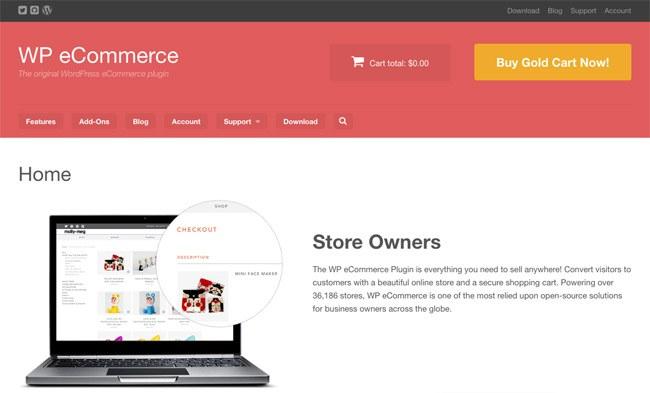
WP Ecommerce is the overshadowed cousin of WooCommerce. They’re not technically related at all, but it’s a solid WordPress plugin that doesn’t get nearly as much attention as WooCommerce.
Let me tell you how it works. First, you install WordPress on your hosting server, followed by the WP eCommerce plugin.
This transforms a regular WordPress dashboard into an ecommerce control center. So, you can add products, run promotions, create categories, and more.
As simple as that!
Smaller sites will be fine with the plugin, but you have to install paid add-ons for extra functionality.
Benefits of WP ecommerce:
- The plugin supports about a dozen payment gateways, but WP eCommerce provides support if you need to go with a gateway that isn’t in the system.
- The backend is easy to navigate and the frontend results look pretty clean and modern. What’s more is that you can customize all of this easily with some simple CSS and HTML.
- WP ecommerce offers a robust coupon feature that allows one-time use, values based on percentages or a hard number. You can also put restriction on certain products from the discount.

- You can pay for direct customer support.
- SSL is provided out of the box for your checkout on your store.
Downsides of WP ecommerce:
- There aren’t many add-ons, in fact, there are only 16 available in the store.
- The multi-lingual tools are just okay. Apparently, there are more advanced multilingual and multi-currency tools coming in the near future, so I’ll see how that goes.
- You can pay extra for premium support which offers training videos however there are a number of reviews on WordPress that suggest these aren’t actually given to you. Currently, the training videos just go to a 404 page.

- You’re not going to find nearly as many WordPress themes for WP eCommerce as you are for WooCommerce.
- According to the WordPress site, the plugin hasn’t been updated in the last year
13. Ubercart

Ubercart is often compared to Drupal Commerce in blog posts.
Drupal Commerce was created by an old Ubercart developer. Therefore, many people argue that Ubercart is the best because it’s the original and has more features to play around with, while others state that Drupal Commerce is the more improved version of Ubercart.
This is what you can normally find when an employee leaves his or her company to create an own and fire up the competition.
But, there are significant differences, making it rather important to find the one that fits your business the best. It would be a pain to migrate from one to the other after making a wrong choice.
In short, both are highly customizable, but Drupal Commerce is more geared towards complex customizations. Most of the differences can be found in the extensions and add-ons since some extensions just aren’t available in each library.
That’s why it’s essential to research which add-ons are needed for your company before pulling the trigger on an ecommerce platform like this.
Benefits of Ubercart:
- The activity logging in Ubercart is a fancy way to locate order statues no matter where a customer is in the purchasing process.
- Although both Ubercart and Drupal Commerce are developer friendly, I’d argue that Ubercart is better for less experienced users.
- It’s simple enough to work well for smaller stores, but you do have the capabilities to expand.
- There are some fantastic tutorials on how to perform actions that are frequently asked. Just click them and it links through to their YouTube channel.
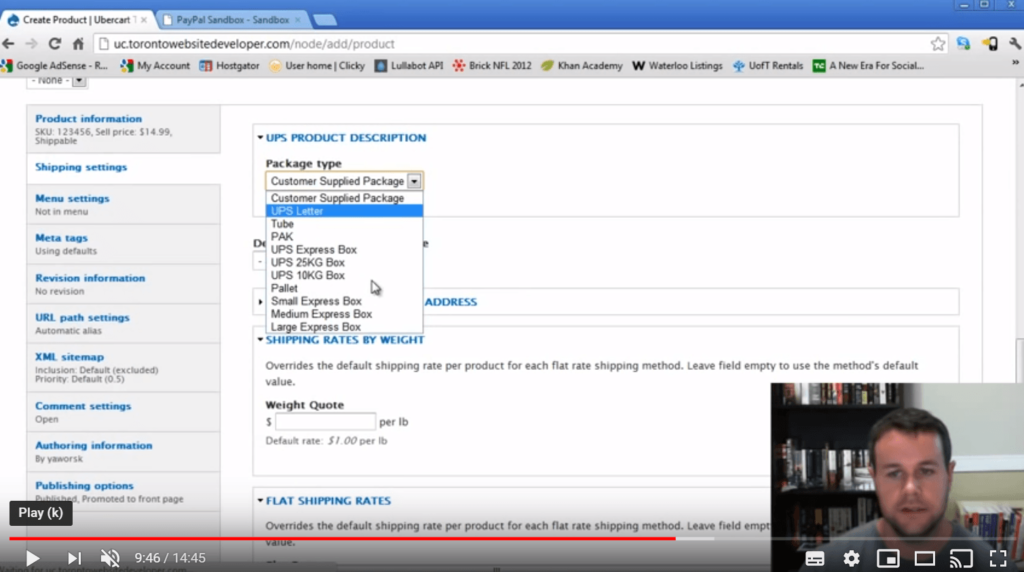
- Payment modules and shipping options are all packaged into the open source ecommerce platform. Therefore, you don’t have to think much about that when launching.
Downsides of Ubercart:
- The customization controls are less powerful in Ubercart when compared to Drupal Commerce. This can be a good thing for newer developers, but some more advanced users might want more.
- Although you can scale up to support lots of products and product variants, Drupal Commerce is definitely more suitable for a large online store.
- Ubercart advertise a demo version of their platform, however, when you click this the website doesn’t exist

- As you can see from the screenshot above, Ubercart hasn’t been updated since February 2018 which is almost a year. Open source platforms develop bugs and need to be updated more regularly than that.
- The SKUs are not as cut and dry as the competition, so users may have trouble when working with weight calculations for shipping.
14. Wix Ecommerce
I bet you’ve heard about it already. Wix is undoubtedly one of the most renowned cloud-based online store builders.
Although the bulk its packages are premium, it turns out Wix also offers an extra option that you can take advantage of to set up an attractive free website.
The best thing about this specific platform is this- even free users can take advantage of its intuitive drag-and-drop website builder to design an entire site without coding. As a matter of fact, you should be able to complete a basic free website within a couple of minutes.
The free plan is particularly ideal for beginners who need powerful tools for building and hosting a standard business website. It grants access to a wide array of customizable predesigned templates plus supplementary icons, clip arts, and images.
Then you know what? You also get to promote your free business site, thanks to the simple SEO and email marketing capabilities that Wix offers at no charge. You can combine that with many other free applications from the Wix App Market to form a dynamic marketing framework.
And in case you’re worried about space, you should rest easy because it’ll probably take you quite some time to exhaust 500MBs of free site storage. The corresponding bandwidth, on the other hand, extends to 1GB on a domain that rides on the Wix platform. In other words, your free domain name will be something like username.wixsite.com/site address.
But, here’s the thing. You still get secure web hosting, 24/7 unlimited support, plus automatic mobile optimization. So, of course, your visitors will be able to surf conveniently from any device.
Unfortunately, Wix will bombard your free website with ads. The only way you can avoid that is upgrading to one of the premium plans, which start at $4.50 a month. And that comes with a host of advanced features like form builder, custom favicons, email campaigns, etc.
That said, real ecommerce website tools are not accessible until you subscribe to the Wix eCommerce plan for $16.50 a month. And if you need superior online selling functionalities, you can scale further and settle for the VIP plan at $24.50 a month. This specific one is essentially optimized for growing ecommerce sites.
Benefits of Wix Ecommerce
- It provides an extremely simple plus straightforward drag-and-drop website builder. You can design then customize a full free site without any coding skills.
- Although online store features come at a price, let’s be honest and admit that the packages provide great value. You only get to pay at least $16.50 for powerful ecommerce site functionalities.
- Wix comes with an extensive collection of elegant site themes and templates. They are all designed by professionals for extra responsiveness and mobile optimization.
- You can leverage numerous apps from the extensive Wix App Market if you intend to add functionalities to your premium site. Some of the supplementary ecommerce website capabilities available at this level include abandoned cart recovery, payment processors, global shipping providers, and much more.
- Wix does not take a cut from your payments when you sell online from your ecommerce website. Only payment processors will deduct their fair share of transaction fees.
Downsides of Wix Ecommerce
- It’s impossible to set up a fully-provisioned free ecommerce website. You only start selling after you’ve upgraded to, at least, the eCommerce package at $16.50.
- The free plan comes with ads that may tamper with your site’s overall layout. The web pages will subsequently look busy and cluttered.
- Wix doesn’t provide access to its underlying code. So, of course, you cannot customize your website extensively. You’re basically limited to what the themes and templates allow.
- Once you start working on a specific website theme, you cannot shift to a different one halfway through the editing process. You have start over again.
15. Branchbob

There’s no shortage of options when it comes to finding the best free Ecommerce platform these days. From better-known tools like Ecwid, to new options like Branchbob, there are plenty of ways to start taking credit card payments. The key to success is finding something that works for your team.
Branchbob is a lesser-known ecommerce platform that promises ease of use and simplicity. There’s no monthly fee or transaction fees to worry about. What’s more, the tool is clear, straightforward, and excellent for beginners. Branchbob even performs well when it comes to optimized payment processes and page speed too. Faster page performance means that you can deliver better experiences to your target audience.
Like most eCommerce tools, there’s support for unlimited products, on a platform where you can choose your own design from a range of templates. What’s more, Branchbob aims to be the best ecommerce platform around for both developers and designers. You can access the full source code behind the software to adjust it to your needs. There are even more than 100 APIs to experiment with.
If you’re not certain how to make the most of code, you can always use the Branchbob Experts too. These are professionals that can help with building your site, for a fee.
Benefits of Branchbob
- Lots of flexibility for people who know code
- Excellent design and developer functionality
- Fast page speed and image optimization
- On-page SEO included
- Expert access for beginners
- No fees, including transaction fees
Downsides of Branchbob
- You’ll need some coding knowledge to get the most out of the tools
- The ecommerce capabilities are limited in some areas
· This tool isn’t as well known as other ecommerce website builder products
16. Big Cartel
Big Cartel is not your regular platform for typical ecommerce websites. Rather, it’s optimized for artists and creators.
If you’re one, then here’s the good news. You can use Big Cartel to not only building a specialized free ecommerce site, but also proceed to sell your artworks.
The simple online store features on this platform are particularly suitable for individuals and small businesses that might not be expanding any time soon. And in case you face challenges while setting up your ecommerce website, you can rely on Big Cartel’s onboarding process to guide you accordingly.
Sadly, things might turn out to be disappointing when you start adding products. From the look of things, free ecommerce websites can only sell five products. And to make matters worse, you only get a single image per item.
However, on the bright side, at least you can also sell them on Facebook and in-person. Plus, you can always upgrade to a paid plan when you need additional functionalities. The most basic one supports 25 products at $9.99 per month.
Benefits of Big Cartel
- Big Cartel provides a wide range of specialized ecommerce tools for selling artworks.
- While coding is certainly the best way to fully capitalize on Big Cartel’s store building functionalities, you can customize its predesigned themes to create a unique free ecommerce website.
- It possible to generate additional revenue by going beyond your ecommerce store to sell on Facebook and in-person.
- The user-friendly on-boarding framework makes it incredibly easy to build an ecommerce website.
- If you have the requisite coding technical skills, you can go ahead and customize your site extensively.
Downsides of Big Cartel
- Big Cartel does not provide advanced ecommerce website features. It principally targets artists and creators.
- You need coding skills to achieve a holistically tweaked online store.
- The Big Cartel free plan comes with very limited selling capabilities. As a result, your free ecommerce site can only accommodate five products.
17. Jimdo
Jimdo is another beginner-friendly website builder that happens to offer supplementary ecommerce features.
Right off the bat, you can leverage its Dolphin AI system to create a custom free website in a few minutes. But, if you’d prefer to take charge of the whole process, you can opt for the alternative creator website building mode. It comes with additional privileges for editing Jimdo’s predesigned themes.
Unfortunately, you won’t be able to sell anything on your free site. To unlock online store functionalities, you have to subscribe to either the Ecommerce plan for $19 per month, or Unlimited for $39 per month. And each of these paid packages, for your information, are billed on a yearly basis.
Well, if you decide to proceed, you’ll notice that Jimdo’s online store features are seemingly suitable for basic ecommerce websites. Therefore, it’s more of a website builder than an ecommerce platform.
Benefits of Jimdo
- The Dolphin AI website builder on Jimdo automatically generates an ideal layout based on your preferences and site details.
- Jimdo offers an array of predesigned themes for standard sites, business sites, and ecommerce websites.
- You won’t be paying Jimdo every time you conduct a transaction on your store.
- To help you rank favorably on Google, Jimdo comes with ready SEO features.
Downsides of Jimdo
- It’s not possible to set up a free ecommerce website on Jimdo. You can only access selling features after subscribing to either Ecommerce or Unlimited paid plans.
- Jimdo’s online store features do not support the selling of digital goods.
- The ecommerce capabilities here are quite limited. You’ll only be able to create and run a basic ecommerce website.
18. Ecwid
Ecwid essentially translates to “ecommerce widgets”. And just like the name suggests, this is not a distinctive ecommerce platform.
Instead, it’s a shopping cart that you can integrate with any site to transform it into a fully-fledged online store. However, as you might have guessed already, you need some lines of code to achieve that.
While Ecwid offers three paid packages, it also provides a free option- which, unlike Jimdo, comes with decent ecommerce capabilities. Apart from unlimited bandwidth, you get a mobile responsive design, two product categories, and support for 10 items.
Sadly, you won’t be able to sell digital products at that level. Plus, your online store functionalities will be limited to a one-page ecommerce website. The only way to escape from that, of course, is subscribing to one of the premium plans, which start at $15 per month.
Benefits of Ecwid
- You can use Ecwid to transform any site into an ecommerce website.
- Its basic online store functionalities are ideal for startups and small businesses.
- The entire shopping cart is automatically optimized for mobile.
- You can take advantage of Ecwid to sell concurrently on multiple websites.
- Ecwid does not charge any transaction fees.
Downsides of Ecwid
- Ecwid does not offer advanced ecommerce features. So, of course, you cannot use it on a large dynamic online store.
- Embedding Ecwid into an existing site requires some coding skills.
19. Weebly
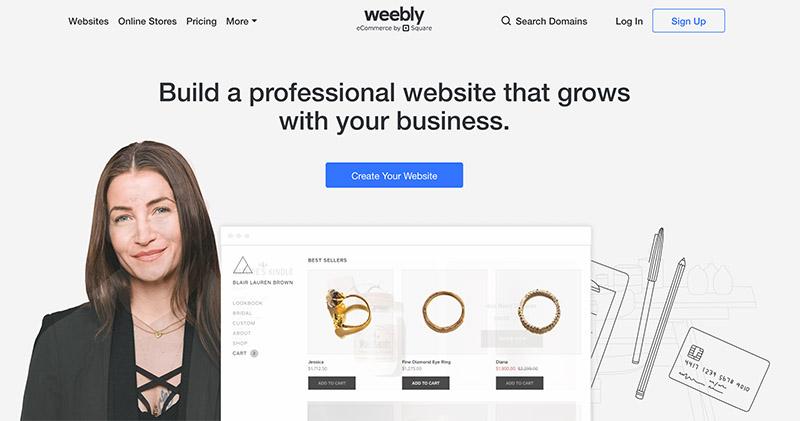
Weebly is one of the most generous tools for payment processing and site building on the marketplace today. Similar to Squarespace and Square, Weebly offers a state-of-the-art site building experience that’s great for beginners.
Weebly only recently made ecommerce functionality available as part of its free plan. However, that means that store owners can now unlock all the benefits of Weebly selling without having to spend a fortune. Whether you’re selling physical products and need help with inventory tracking, or you’re selling online services, there’s something for everyone with Weebly.
The biggest downside for business owners using Weebly is that there are a few ecommerce options missing. For instance, it’s hard to figure out how to sell on social media and tracking your stock levels isn’t always easy either.
The good news is that Weebly does come with the ability to add unlimited products and choose from a range of payment options. However, it’s worth noting that those payment methods do come with a significant transaction fee. What’s more, like with many of the other best ecommerce platform options, Weebly doesn’t offer a custom domain with its free plan.
Benefits of Weebly:
- Easy to use for beginners
- Ecommerce tools recently added to the free plan are quite straightforward
- Access to unlimited products, so you can sell as much as you like
- Easy to get started for business owners without much experience.
Downsides of Weebly:
- Hefty 2.9% transaction fee with 30c processing fee
- Not ideal for large businesses with lots of products to sell
- No support for multi-channel selling
- No custom domain, and there will be ads on your site
FAQ
Can I build an Ecommerce Website for Free?
Yes, of course you can. Most of these platforms we’ve covered allow users to set up free ecommerce websites with limited functionalities. But, there are a couple of exceptions like Square, for instance, that are generous enough to provide full ecommerce features at no cost.
What’s the Best Platform for Building an Ecommerce Website?
Although there are a number of seemingly dominant options you might have heard about, the ecommerce platform market is quite extensive. There are numerous options offering varying features, and some of them come with tools that have been optimized for specific types of stores.
Needless to say, there’s no ultimate platform for building an ecommerce website. Rather, the suitability of a platform depends on your particular needs.
How Long Does it Take to Build an Ecommerce Website?
Fact is- it might take you five minutes, ten minutes, hours, or even days. It all depends on your skills, the type of online store you’re building, its overall complexity, plus the website building functionalities offered by the platform you choose to leverage.
That said, it’s always advisable to select a platform that combines a user-friendly website editor with dynamic customization features.
A good example is Shopify, which provides favorable functionalities for creating an ecommerce website in less than 15 minutes.
Is A Free Ecommerce Platform Right for You?
Again, it all depends on your precise needs and the corresponding ecommerce platform you select.
While the bulk of free ecommerce platforms are only capable of building and running basic online stores, there are still free open-source solutions like Magento and WooCommerce, which can be coded to support complex sites.
Conclusion: Is An Open Source Ecommerce Platform Right for You?
I just want you to know that there are many other open source software which I haven’t mentioned.
The best part is every single one of these is free and constantly in development. That’s a huge plus if you’d like to save a little money in the short term and scale up easily in the long term.
Even though open source ecommerce platforms have their advantages, you should seriously consider a non-open source solution like Shopify, BigCommerce, or Volusion. With these platforms you only pay a small monthly fee, you don’t have to maintain your site as much or look for hosting, and always get dedicated customer support.
In my opinion, this type of ecommerce frameworks is for rapidly scaling companies that are going to hire a developer (or a team of developers) to run the entire website. But if you don’t have the money for this type of employee, you’re better off scaling up with something like Shopify.
If you have any questions about this take on open source ecommerce platforms, let us know in the comments below.


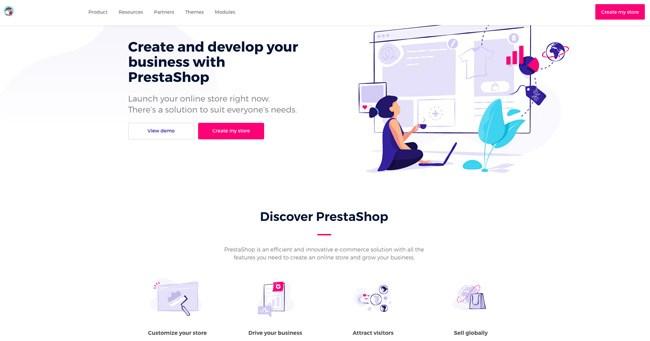


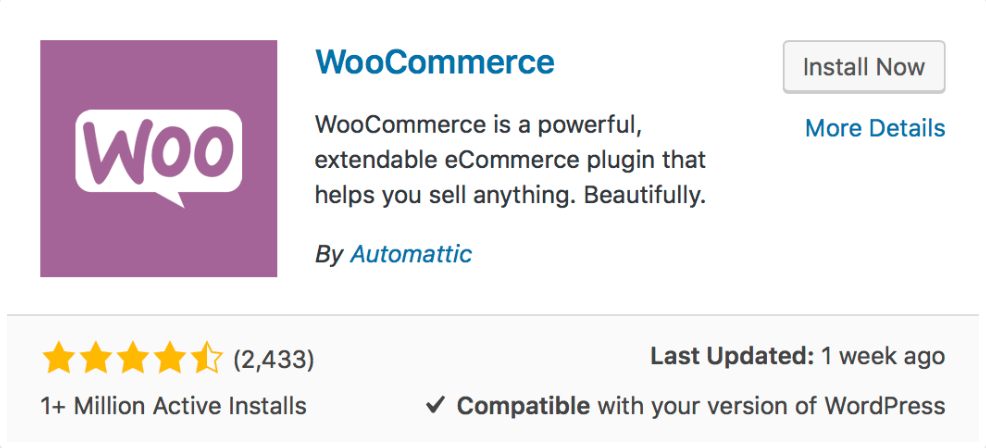

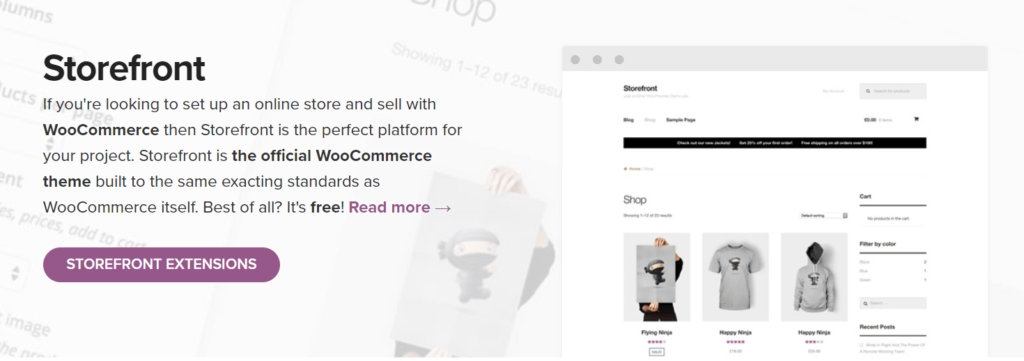


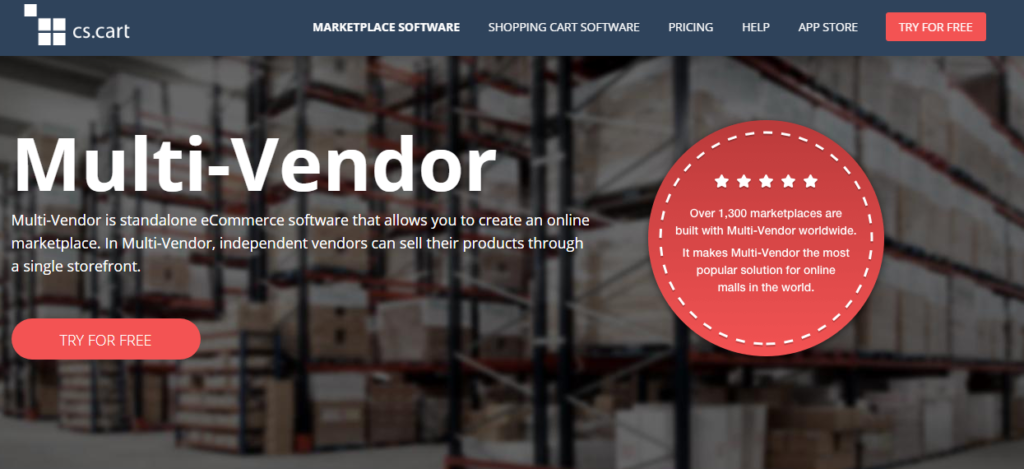



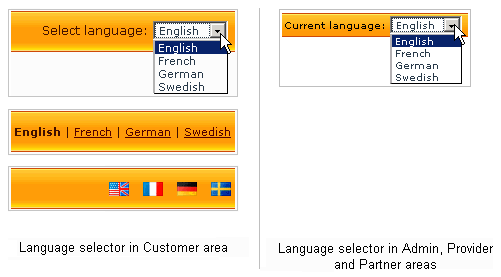




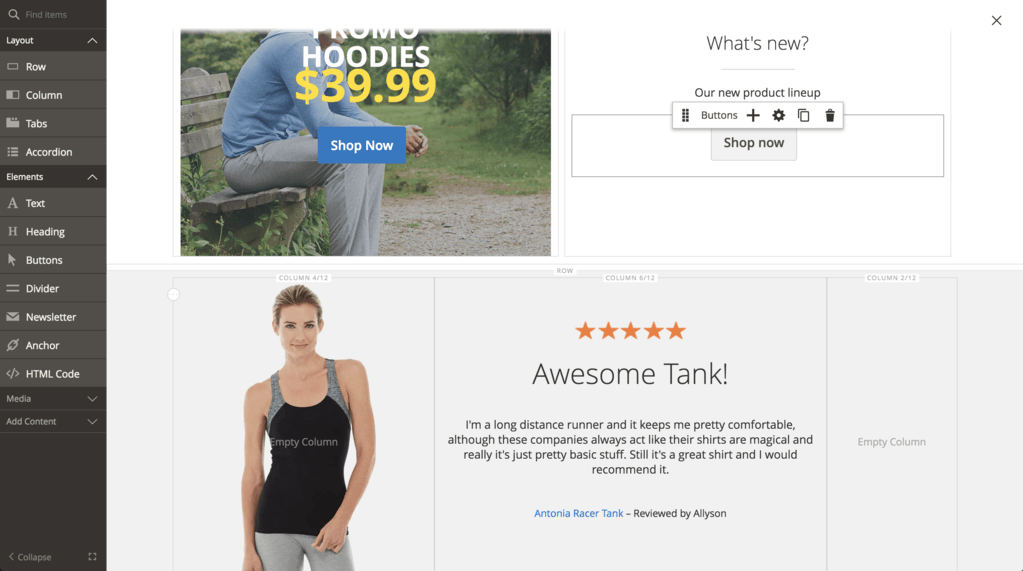

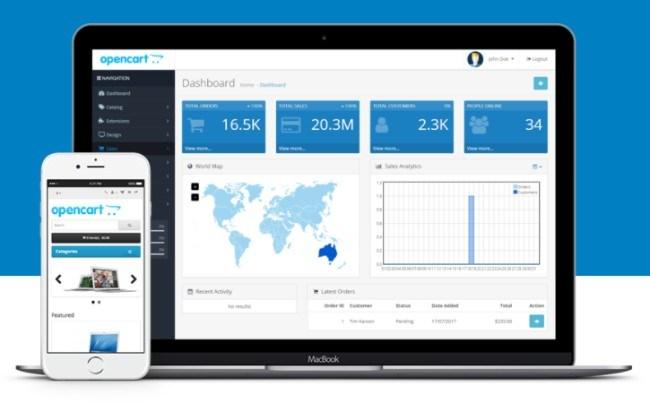
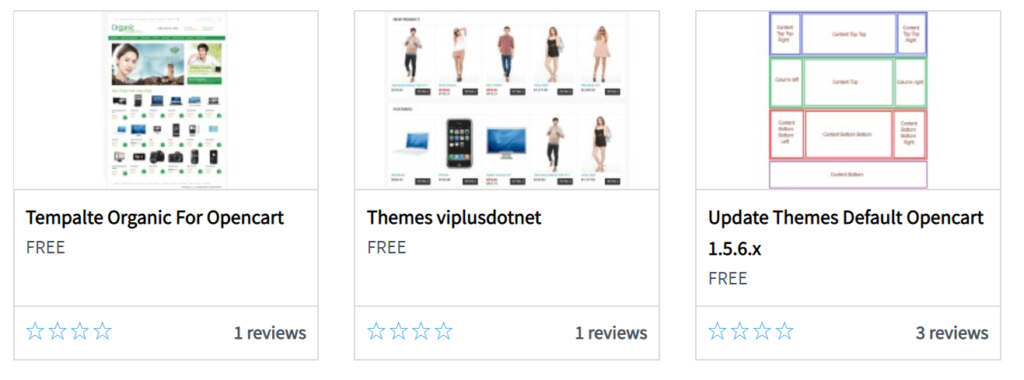


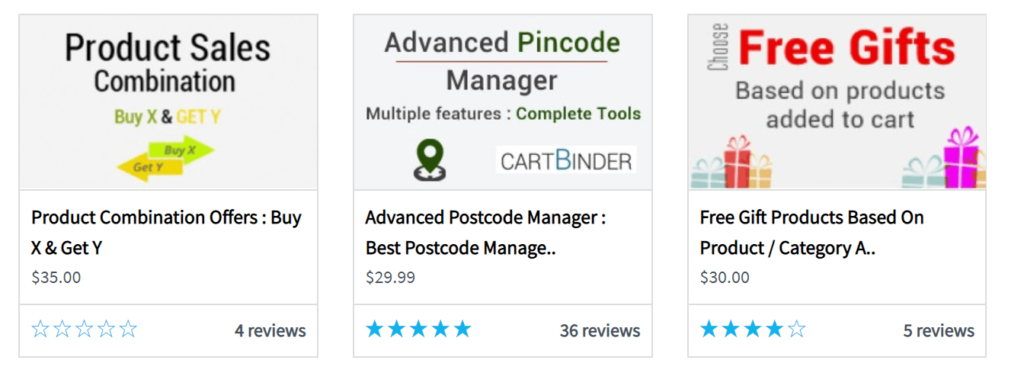


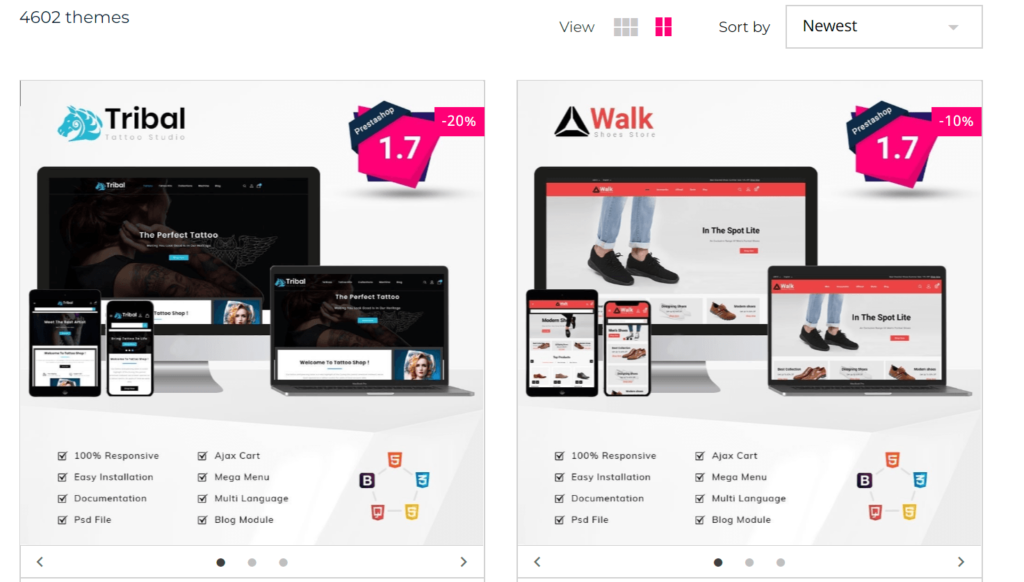

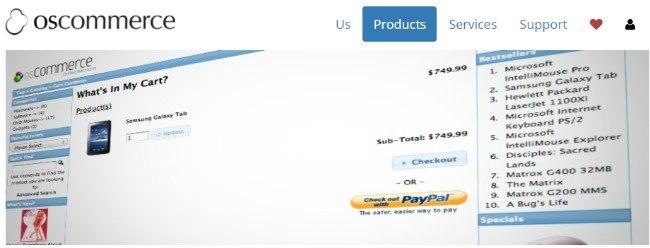

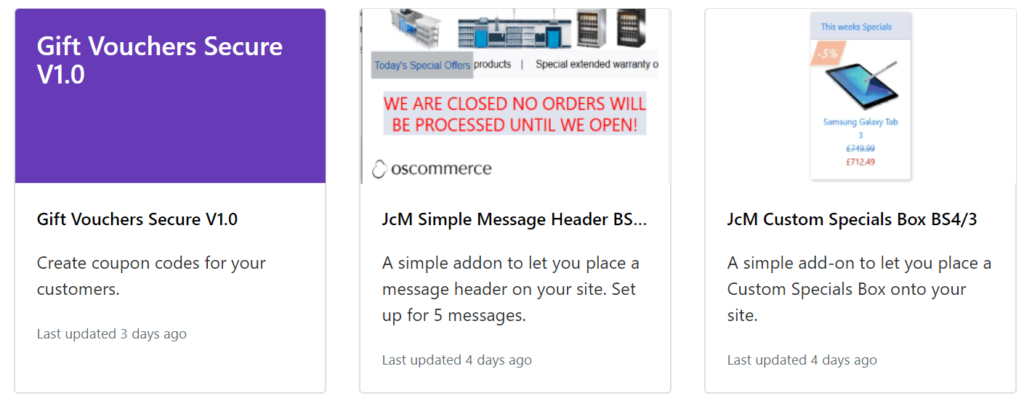





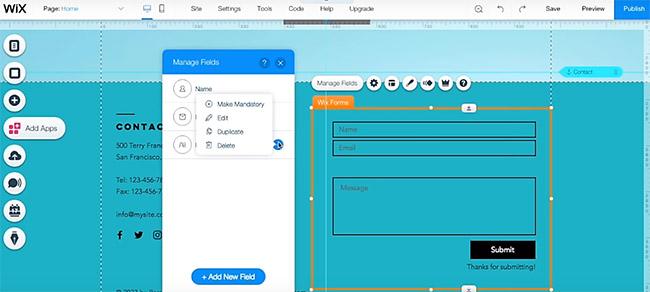

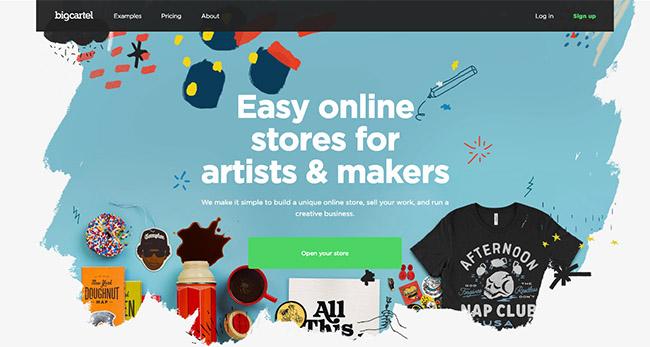

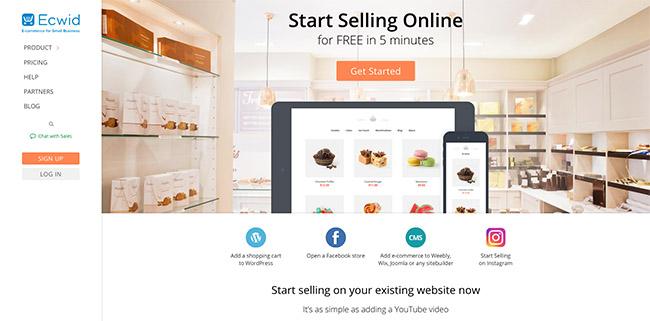
Pingback: 10 Important Ecommerce Tips for Small Business - InterWeb SA